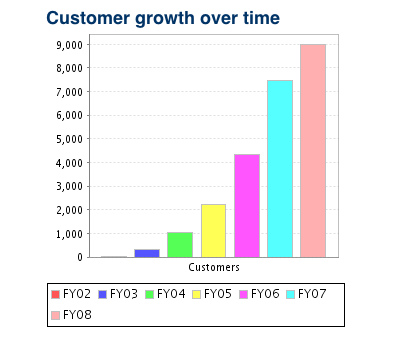Are we heading into Recession? The “Big R” talk of early this year quickly subsided, economic growth returned, the markets appeared to vindicate the optimists. US Presidential Candidate John McCain repeatedly said the economy was fundamentally strong… until just days ago, when he quickly switched to declaring a crisis. The Wall Street Journal says we’re in the Worst Crisis Since ’30s, With No End Yet in Sight.
 I don’t claim to be an expert economist, so whether the Big R is looming is not my call – but if you believe we’re in a strong economy, I have a bridge to sell you. Let’s just focus this discussion on how Software businesses can survive in a financial crisis, which is undeniably here.
I don’t claim to be an expert economist, so whether the Big R is looming is not my call – but if you believe we’re in a strong economy, I have a bridge to sell you. Let’s just focus this discussion on how Software businesses can survive in a financial crisis, which is undeniably here.
Not all will survive, and it’s probably healthy they won’t. Tim O’Reilly, Father-of-all-things-Web-2.0, asked the question at the Web 2.0 Expo last week:
Global warming. The U.S. losing its edge in science and technology. A growing income gap. “And what are the best and the brightest working on?” O’Reilly asked, displaying a slide of the popular Facebook application SuperPoke, which invites you to, among other things, “throw sheep” at your friends.
“Do you see a problem here?” he posed, showing another slide of the popular iPhone app “iBeer,” which simulates chugging a pint. “You have to ask yourself, are we working on the right things?”
The poster-child of the Web 2.0 boom may very well become the symbol of what went wrong:
- useless
- consumer-only
- ad-driven
Actually, the problem is not what they do, but how seriously they were taken. Will Price, a very smart VC said long ago:
It may well be that Slide raising $55m from mutual fund companies at $500m+ pre-money will be the “what were we thinking” moment of the current cycle.
I’m glad they did not go public, at least not a lot of people will get hurt holding the bag. But enough of what’s wrong, here’s what works:
- go where the money is, and that’s businesses (“Enterprise” vs. consumer, even if it means small business)
- deliver value – useful functionality that improves business
- charge for it – companies actually prefer to pay for reliable, good service.
The last point brings up the price issue. Credit will dry up. Whether we’ll officially declare Recession or not, the fear of the Big R is enough for corporate budget cuts, the disappearance of any CAPEX spending. Even worse, an entire sector almost disappeared as IT buyers. Did you know that Lehman Brothers spent over $300M on IT in just the last quarter, right before declaring bankruptcy? How do you sell in this environment?
The after-bubble nuclear period of “no IT spending at all” found me at a startup in 2001-2003. We did not exactly hit it big, but did not go under, either, and that’s because our model allowed us to get in the door way below the threshold that would have required higher authorization. Not classic SaaS, rather SES (Software Enabled Service), we were essentially data providers and often got into an “enterprise” account at $3k for the first month … eventually ramping up to annual $60-$100K. Anyone familiar with Enterprise Sales knows the term Economic Buyer: typically getting involved later at the sales cycle, approving or nuking the deal. Well, we saw no Economic Buyer: being under the threshold, we sold to the User directly.
Of course my little business is not the only proof: Salesforce.com & WebEx thrived during the last recession. The secret is the business model: pay-as-you-go. SaaS offers lower risk to enter, no initial cash layout, the subscription fees come out of OPEX vs. CAPEX, and is often approved by the User, not the mysterious Economic Buyer. The barrier of entry is much lower: once you’re in, it’s up to you to grow.
In fact I suspect the looming downturn will accelerate the structural changes in the software industry: SaaS players will thrive, traditional on-premise vendors will shrink, many will disappear.
That leaves a final point to discuss: financial solvency. For startups, it will be increasingly hard to find investors. For larger businesses the lack of late-stage investment, the credit crunch may be a serious impediment to expansion. Discover the beauty of bootstrapping – you actually get to do what you believe is right for your business, not what your Board tells you. Do less, take small steps. Frugality is key to survival. Small is beautiful will get a new meaning.
In summary, Software businesses that combine good old business sense: frugality, spending wisely, delivering value to businesses and getting paid for it, with a new business model, SaaS are likely winners in the downturn. The rest are playing musical chairs. (Oh, and the bridge is still available)
(This post originally appeared on CloudAve. Keep informed by grabbing our feed here.)
Related articles by Zemanta
- Goldman, Morgan Stanley Become Bank Holding Companies as Government Tries to Pass Bailout
- Wakie Wakie Web 2.0, Daddy Says It’s Time To Earn A Living
- O’Reilly: Stop throwing sheep, do something worthy
- O’Reilly signals Free Web 2.0 party is over?
- Why it will be very different this time
- Surviving the Financial Crisis
- The Financial Crisis: A Survival Guide for Startups
- Recession Proof Software? Try SaaS, Managed Services and Open Source
- Software for the “Recession Diet”

![Reblog this post [with Zemanta]](https://www.zoliblog.com/wp-content/uploads/HLIC/1e888c58c2f8097a76d183db620f05dd.png)
 The belts will be tightened, says the
The belts will be tightened, says the  Yes, Dan is right, “Web/Enterprise 2.0 startups can’t get a hearing with CIOs and tech buyers at corporations” and their apps are not considered mission critical, but the whole point is that a lot of these Enterprise 2.0 tools are not sold at the CIO level.
Yes, Dan is right, “Web/Enterprise 2.0 startups can’t get a hearing with CIOs and tech buyers at corporations” and their apps are not considered mission critical, but the whole point is that a lot of these Enterprise 2.0 tools are not sold at the CIO level. 
 The
The  ) – but that’s typically in the context of Software as a Service, and in the SMB (small business) market. Atlassian’s products are mostly on-premise (although they now have a hosted version of Confluence) and their primary market is the large Enterprise. Yet they pulled off what amounts to a small miracle: essentially took the download.com, tucows style model we all know as consumers, and ported it to the enterprise space.
) – but that’s typically in the context of Software as a Service, and in the SMB (small business) market. Atlassian’s products are mostly on-premise (although they now have a hosted version of Confluence) and their primary market is the large Enterprise. Yet they pulled off what amounts to a small miracle: essentially took the download.com, tucows style model we all know as consumers, and ported it to the enterprise space. 
 So what is this culture like? Tough. When he doesn’t make his numbers, Atlassian President Jeffrey Walker is forced to make up for it as ticket-scalper on the street.
So what is this culture like? Tough. When he doesn’t make his numbers, Atlassian President Jeffrey Walker is forced to make up for it as ticket-scalper on the street.  OK, joke apart, this photo was shot last August, when the entire San Francisco office went to see a
OK, joke apart, this photo was shot last August, when the entire San Francisco office went to see a  ) I wonder when the San Francisco office will move into a winery… Perhaps
) I wonder when the San Francisco office will move into a winery… Perhaps  you get the picture by now: Working for Atlassian isn’t just a job – it’s a
you get the picture by now: Working for Atlassian isn’t just a job – it’s a 

Recent Comments